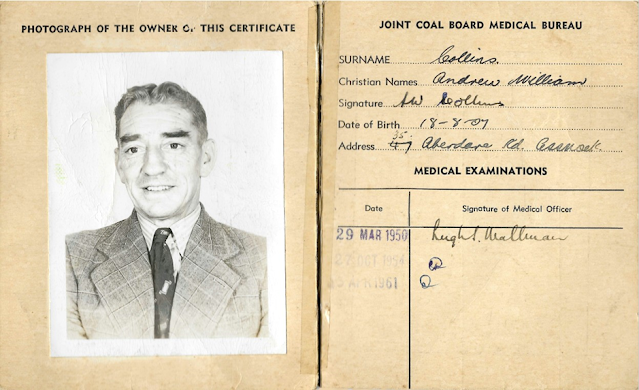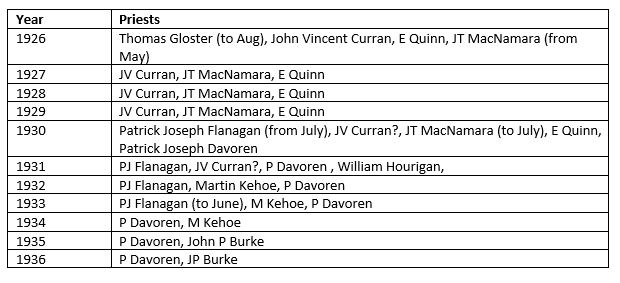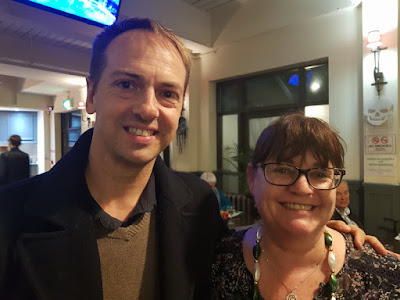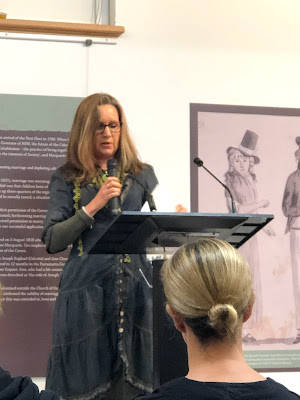While researching the land petitions and dealings of my convict ancestor, Esther Salamon Spencer Stubbs Bigge, I came across a document (1) at
State Archives New South Wales which quoted:
That your petitioner has been a resident in this Colony thirty seven years during which period she has resided in Phillip Street Sydney and maintained herself and a numerous family by her own industry.
That your petitioner has had sixteen children Ten of whom are now alive and also Twenty one Grand-children now living.
 |
| 1831 letter to Colonial Secretary (1) |
This letter was written for Esther by someone unrecorded to the Colonial Secretary of New South Wales in 1833,
Lieutenant-General Governor Ralph Darling. She is petitioning for a town allotment to build a house upon. I don't think she was ultimately successful as she died in her Phillip Street house in October 1855 (2).
 |
| Death notice for Esther Bigge, 1855 (2) |
There have been several publications outlining Esther's children, but these could only account for up to 13 of them.
Children to convict John Fitz
1. Susannah 1797-?
2. Joseph Clark 1799 - 1800
Children to convict Thomas Stubbs
3. Mary Ann (my 4x great-grandmother) 1801 - 1860
4. Thomas 1802 - 1878
5. Sophia 1803 - 1803
6. Cecilia 1805 - 1896
7. Elizabeth 1808 - 1888
8. Annie Esther 1809 - 1837
9. George 1811 - 1838
10. John Emery 1812 - 1836
11. Godfrey 1814 - 1814
Children to husband Joseph Bigge
12. Robert 1816 - ?
13. Louisa Merrite 1817 - 1854
So where did this claim of having 16 children come from?
In the New South Wales register of Births, Deaths and Marriages there are a few entries that don't quite add up. This is pre-1856 so we only have baptismal register entries to work from.
Firstly, the child named Susannah. In the indexes there are two baptism entries per child, but Susannah has four. Looking carefully at the microfilm copy of the register it appears that Esther gave birth to a Susannah on 23 July 1797 and another one on 28 December 1798, 17 months apart.
So we have:
#1 Susannah Fitz, born 23 July 1797, baptised 20 August 1797, father: John Fitz
#2 Susannah Watson, born 28 Dec 1798, baptised 03 March 1799, father: Michael Watson
 |
| Baptism of Susannah Fitz on 20 Aug 1797 (3) |
 |
| Baptism of Susannah Watson on 03 Mar 1799 (4) |
Although there is no death record to be found, it looks as though Susannah Fitz died before the birth of Susannah Watson, and Esther has used the same name again to remember her infant daughter. One of these girls went on to marry boatbuilder, Thomas Day, in 1816. This must have been Susannah Watson because this same woman died on 24 April 1832, age 33 years as per her death notice in various Sydney newspapers. My conclusion is that it was more likely to be the child born in 1799, as the other child would have been 34 years old at that time.
 |
| Susannah Day death notice - Sydney Herald 1832 (5) |
The same woman was in the New South Wales Census (6) in November 1828, age 29, in the household with Thomas Day and their children. Being age 29 on that date corresponds with Susannah Watson's year of birth.
 |
| Portion of New South Wales Census 1828 showing the Day family (6) |
So with the two Susannahs, we've gone up to 14 children out of 16.
Next comes Elizabeth. It looks like there were two Elizabeths as well as two Susannahs.
One was born on 15 March 1807 and baptised on 03 December 1809, age two years and eight months.
 |
| Baptism of Elizabeth Stubbs on 03 Dec 1809 (7) |
The other was born one year later on 11 March 1808 and baptised along with six-month-old sister, Ann, on 18 October 1808, age 16 days. This Elizabeth lived to adulthood, marrying John Jones and dying in 1888 at age 80. Her headstone at Rookwood Cemetery shows her date of birth as 11 March 1808. I love it when there are birth dates as well as death dates on headstones. It makes it so much easier for us genealogists to narrow down the right person.
 |
| Baptism of Elizabeth Stubbs on 18 Oct 1808 (8) |
 |
| Grave of Elizabeth Stubbs Jones at Rookwood (9) |
Having two dates of birth recorded makes these Elizabeths obviously two separate girls. Why would she call a second daughter Elizabeth when she already had a living one? Why was the first Elizabeth baptised after the second Elizabeth was baptised? I live in hope of finding the answers to these questions.
We're up to 15 children now.
When Esther arrived on the
Indispensible in 1796 she arrived alone. Looking at newspaper accounts of her trial in London in 1794 she claimed to be pregnant, although this was not mentioned at her trial, just in newspaper reports pleading for clemency. Firstly, I was not surprised that she would claim to be pregnant. Who wouldn't, if it would save you from the death penalty?
 |
| Extract from the Sun newspaper, London, England, Monday 21 July 1794 (10) |
Conditions within Newgate would surely be detrimental to a healthy pregnancy, moreso to a newborn baby. I haven't found a baptism for this child, but I'm sure Esther would not have forgotten the existence of this child as she got on with her life in New South Wales. The child might have been miscarried, stillborn, or born and lived only a short while. Whatever happened, Esther would have surely counted this child in her tally of babies that she had given birth to throughout her life.
16 children. All acknowledged, and none forgotten.
1. the Newgate pregnancy 1794
2. Susannah 1797-?, daughter of John Fitz
3. Susannah 1798-1832, daughter of Michael Watson
4. Joseph Clark 1799-1800, son of John Fitz
5. Mary Ann 1801-1860, daughter of Thomas Stubbs
6. Thomas 1802-1878, son of Thomas Stubbs
7. Sophia 1803-1803, daughter of Thomas Stubbs
8. Cecilia 1805-1896, daughter of Thomas Stubbs
9. Elizabeth 1807-1809, daughter of Thomas Stubbs
10. Elizabeth 1808-1888, daughter of Thomas Stubbs
11. Annie E 1809-1837, daughter of Thomas Stubbs
12. George 1811-1838, son of Thomas Stubbs
13. John Emery 1812-1836, son of Thomas Stubbs
14. Godfrey 1814-1814, son of Thomas Stubbs
15. Robert 1816-?, son of Joseph Bigge
16. Louisa Merrite 1817-1854, daughter of Joseph Bigge
(1) Colonial Secretary’s Letters relating to Land 1826-56, item no 2/7801, reel no 1093, document no INX-14-4989. State Archives New South Wales, accessed 6 Oct 2019. https://records-primo.hosted.exlibrisgroup.com/permalink/f/1ebnd1l/INDEX951060
(2) Family Notices (1855, October 29). Empire (Sydney, NSW: 1850 - 1875), Monday 29 October 1855, page 4. Retrieved October 7, 2019, from http://nla.gov.au/nla.news-article12844415
(3) Baptisms from New South Wales Births Deaths Marriages index for 1797. Microfilm viewed at State Archives NSW, accessed 25 Sep 2019.
(4) Baptisms from New South Wales Births Deaths Marriages index for 1799. Microfilm viewed at State Archives NSW, accessed 25 Sep 2019.
(5) Family Notices (1832, April 30). The Sydney Herald (NSW: 1831 - 1842), page 4. Retrieved October 7, 2019, from http://nla.gov.au/nla.news-article60164410
(6) New South Wales Census 1828, State Archives New South Wales, accessed 07 Oct 2019. https://records-primo.hosted.exlibrisgroup.com/primo-explore/fulldisplay?docid=ADLIB_RNSW110001515&context=L&vid=61SRA&lang=en_US&search_scope=Everything&adaptor=Local%20Search%20Engine&tab=default_tab&query=any,contains,NRS-1272&sortby=rank&offset=0
(7) Baptisms from New South Wales Births Deaths Marriages index for 1809. Microfilm viewed at State Archives NSW, accessed 25 Sep 2019.
(8) Baptisms from New South Wales Births Deaths Marriages index for 1808. Microfilm viewed at State Archives NSW, accessed 25 Sep 2019.
(9) Grave of Elizabeth Stubbs Jones, Find A Grave, memorial ID 199553957, accessed 11 Oct 2019.
(10) Sun (London, England), Monday July 21, 1794; issue 565. Accessed 11 Oct 2019.






















































